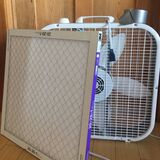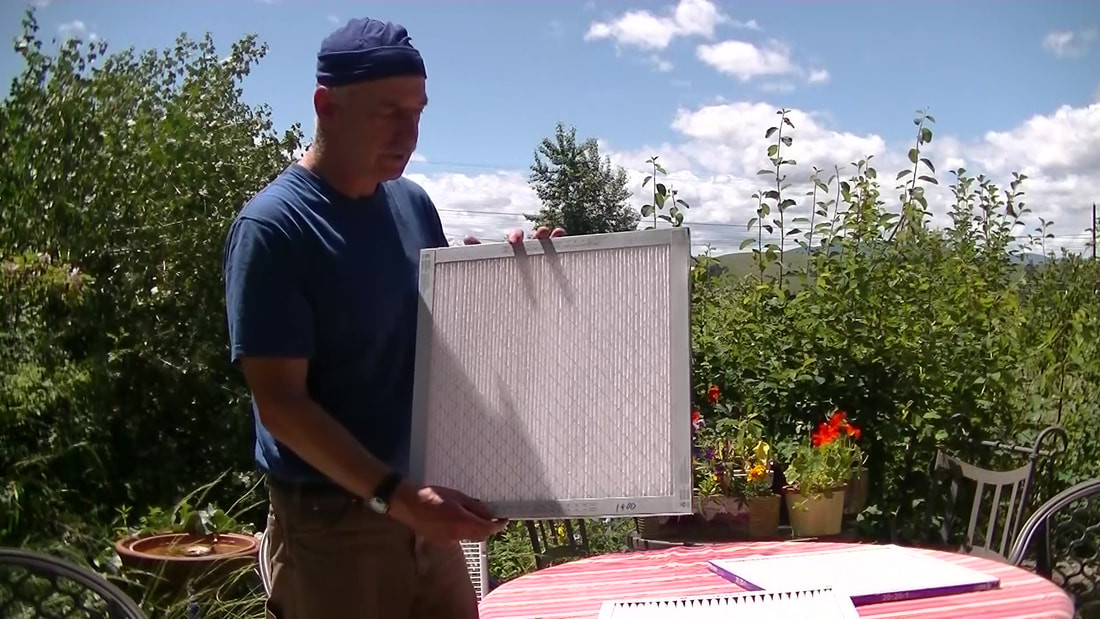
How to Build a Do-It-Yourself Fan/Filter Room Air Cleaner
using a 20-inch Box Fan and a high efficiency air filter
For ~ $40 you can clean the air in a small to medium sized, closed room.
Download our handy one pager HERE.
using a 20-inch Box Fan and a high efficiency air filter
For ~ $40 you can clean the air in a small to medium sized, closed room.
Download our handy one pager HERE.
|
MATERIALS:
ASSEMBLY:
|
Check out or handy short video - everything you need to know to make a boxfan/filter in just over 2 minutes!
|
|
Quick WARNING:
Box fans – if an older model or used incorrectly – can ignite and start a house fire. The most common cause of fires is the motor locking up under load and overheating. You can prevent this if you:
Now you know the risks! We tested several brands of new box fans with filters attached, as described here, and found them to operate at or below their maximum design operating temperature when they are clean and well-maintained. |
You may have heard of the Corsi-Rosenthal Box version of the fan/filter combo. These involve 4(!) filters attached to one fan and work great. Learn how to build one HERE. Although these are awesome - and there's data to show how effective - unless you buy multiple filters in bulk, the price can rival a smaller, quieter HEPA air purifier. ... |
|
A few more details worth knowing
In order to give individuals an affordable DIY option to clean indoor air, especially during wildfire smoke season, we worked with Tom Javins, our local mechanical engineer and consultant, to ensure these are safe! What we have learned from our research and testing: PM2.5 and ultrafine particles can be removed from the air with a DIY room air cleaner. It is most effective with new electrostatic filters having a MERV 11 to MERV 13 filter rating. Equivalent ratings are FPR 10 and higher and MPR 1500 and higher. Change the filter when it changes color to gray or at the filter manufacturer’s recommended time. New electrostatic filters work best for the really small particles that are the most harmful to breath. One filter testing company recommended changing the filter every two weeks for best ultrafine particle capture. A DIY-room air cleaner with a new filter is about as effective as a small or medium sized commercial room air purifier, with a comparable Clean Air Delivery Rate (CADR) based on airflow and the E1 (0.3 to 1 micron particle size) efficiency. The fan motor life is rated for 20,000 hours of continuous operation (24/7) in a room with 104 F ambient temperature. As the air temperature nears 100 F the motor may stop working because the motor is over the safety cutout temperature, this may happen at a lower air temperature if the motor not clean, worn or damaged. Using older box fans is not recommended as they are more likely to catch fire. The more it runs the cleaner the air! |
Tom Javins explains the variety of air filters in this 3 minute video!
|
Abbreviations:
- CADR – Clean Air Delivery Rate, an air purifier rating system from the Association of Home Appliance Manufactures. It is an indication of how much filtered air comes from an air purification system.
- E1 efficiency- The ratio of entering and leaving particles, 0.3 to 1 micron in size, through a filter (Part of the MERV rating system).
- FPR – Filter Performance Rating, a Home Depot filter rating system
- MERV- Minimum Efficiency Reporting Value, a filter rating system that uses the minimum tested particle removal efficiency for filter comparisons. Developed by the American Society of Heating, Refrigeration and Air Conditioning Engineers.
- MPR- Micro-particle Performance Rating, developed by 3M for rating the capture of particles 0.3 to 1 microns in size.
- PM2.5- Particulate Material in the air that is 2.5 microns or less in size.

